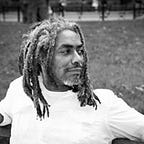Richmond Normal: Rednecks of Stone
Once upon a time, I was an art and theater student at VCU in Richmond, Virginia. Black leather mini skirts were popular. Long-legged coeds were plentiful. I consumed little that was not liquid or smoke. A pack of camels was less than two dollars, a pitcher of beer less than five. I spent my nights talking crap with sundry freaks and geeks at the Village Café on Grace Street, famous for its “diversions for the young and old, rich and poor, wise and otherwise.” I met or met up with some of the most incredible humans I’ve ever known within the walls of the Village Café. I spent a significant portion of my early adulthood there.
It became my normal.
I fell in love at the Village Café and I did so frequently. I fell in love with the conversations, about art, music, politics.
And chicks, man; we always talked about chicks when we weren’t talking to them.
Or at them.
The people I met at the Village were wise and world traveled, some from as far away as Northern Virginia. They were outside my experience, tortured artists, anarchists and pagans. I drank pitchers with prophets, bummed smokes off revolutionaries, battled wits with humans of intellectual fearlessness. Everyone at the Village had a story. Most of us had sagas. We were misunderstood and angst-ridden; we walked with tragedy.
Sitting at those uncomfortable wooden booths, I fell in love with the stories of my fellow Richmonders, and through them I fell in love with Richmond, particularly the fan/downtown area. I used to walk Monument Avenue — one of only two National Historic Districts within Richmond — and dream of someday living in one of those gorgeous old homes. The neighborhood was a living museum of Gothic and Classical Revival style architecture, and baroque monuments of historical figures.
It was quite charming.
One night, while sitting at my favorite booth, pondering the mysteries of the multiverse, I noticed a pleasant-looking young lady in a pleasant-looking mini skirt sitting alone. I had seen her around. We weren’t complete strangers. We’d shared smiles a few times around campus. I invited her to join me at my booth. She obliged. The conversation was awkward at first, but sparked over a shared musical interest and quickly caught fire. Her thoughts were as deep as her legs long. We continued the conversation past last call. I walked her home. She lived north of Boulevard, so we walked via Monument Avenue. Feeling rebellious, we climbed the fence around one of the monuments and hung out beneath a giant stone man bestride a giant stone horse. I lost all sense of time and place as I listened to her story. It was a very tragic tale. And then the cops showed up.
Richmond takes its civil war heroes seriously. There is or was a whole police force solely dedicated to their protection. The monument cops gave Mini Skirt and I a stern talking to before shooing us away to continue our conversation back at her place.
The next morning, returning down the avenue, I considered the scene from the night before, the monument, the mini skirt, and me.
I had a bit of an epiphany then.
Regarding southern heritage and the heroes of racism, there were few acts more subversive than the one Mini Skirt and I had engaged in right there in plain view of Jeb, and Robbie Lee, and all the other racists of stone adorning the avenue. If only they could have seen it. They would have soiled their breeches. At the time, Richmond’s population was around 61% African American, and yet, the entire city –- not just Monument Avenue — was, and probably still is, a living memorial to the champions of slavery. I grew up inside the culture, so I had never even noticed.
It was my normal.
Confederate Flags were common sights growing up on Richmond’s south side. The city proudly hailed itself as the “Capital of the Confederacy.” Even the roller coaster at King’s Dominion was draped with Confederate flags and called, “The Rebel Yell.” Everywhere I looked, larger society embraced a heritage and history that misrepresented the experiences of African Americans, or ignored them altogether. I accepted this. I lived with this truth. Most of us native southerners did. It was our normal. I, a son of slaves, thought little to nothing of loitering on one of those monuments to racism, exchanging kisses with a daughter of slave owners. The irony was completely lost on me at the time.
It was my normal.
That was the moment I resolved to leave Richmond. It was 1989, Autumn, cool enough to comfortably wear my leather motorcycle jacket, the only article of clothing I ever truly loved. I called it the Fonzie Jacket because it bestowed supernatural powers of cool upon its wearer. It would be stolen about five years later from an American Shakespeare Center touring van parked outside a bar in San Francisco. By that time, it would be pretty beat up, mostly held together with gaffer’s tape and hope. But that morning, my Fonzie Jacket was whole and my future clear.
I had to find a new normal.
